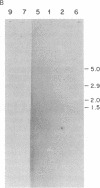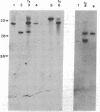Abstract
The I-J subregion of the mouse major histocompatibility complex has been reported to encode antigenic determinants expressed by suppressor T cells. Previously, cosmid clones were obtained from mouse sperm DNA that contain all of the sequences between the I-A and I-E subregions, where I-J has been mapped genetically. However, hybridization of these sequences to RNA prepared from several I-J-positive suppressor T-cell hybridomas did not reveal the presence of a transcript. In addition, no rearrangements in this DNA were detected in the suppressor T cells that we have analyzed. Our results indicate that the I-J polypeptides are not encoded between the I-A and I-E subregions of the major histocompatibility complex. We discuss several hypotheses concerning the possible location and expression of I-J genes.
Full text
PDF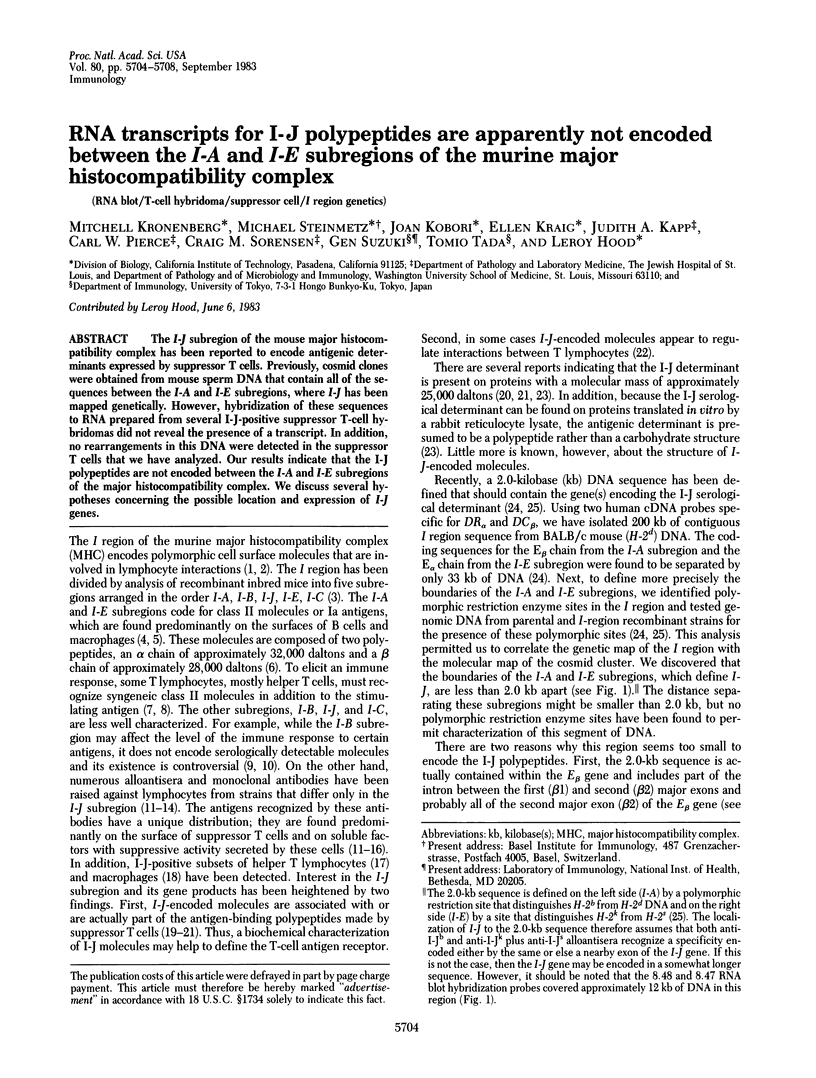
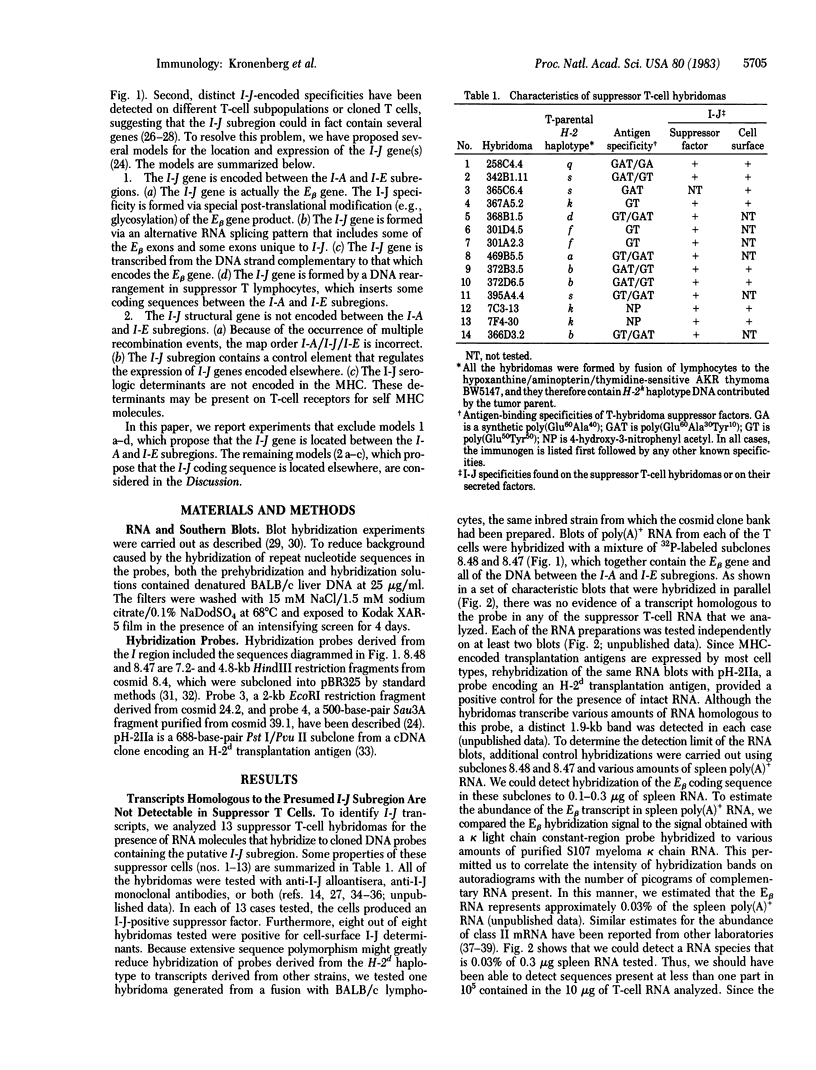
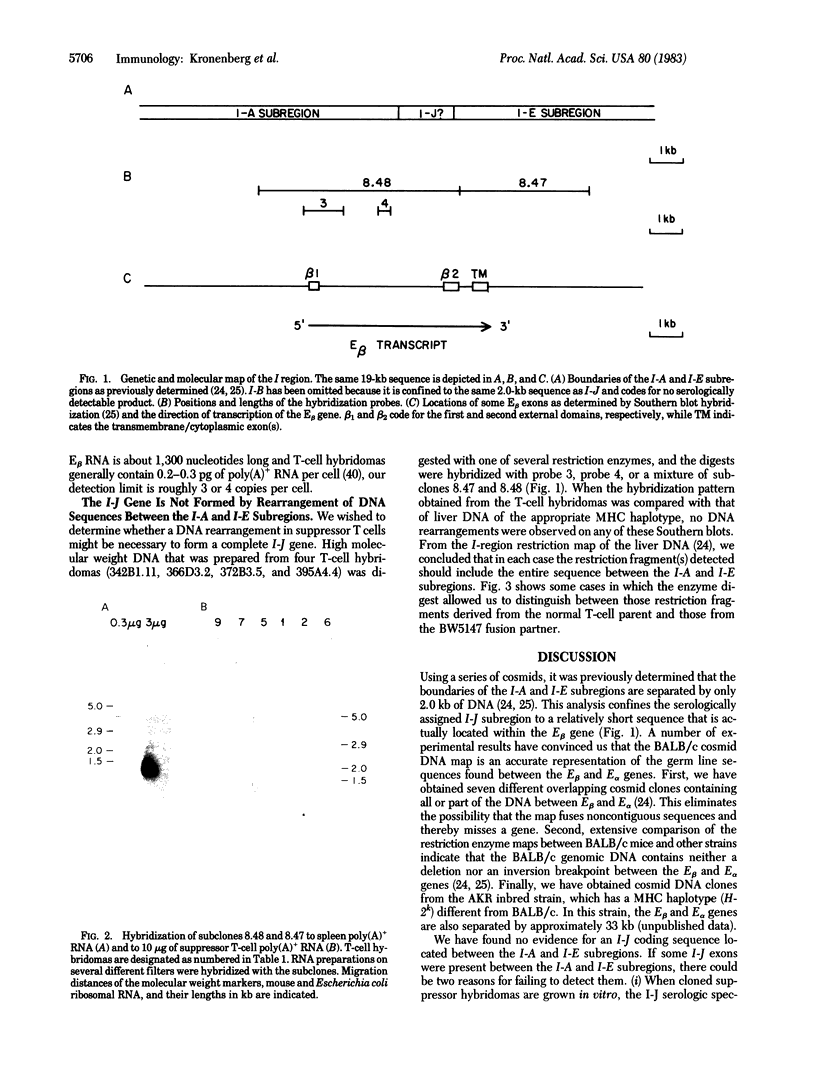
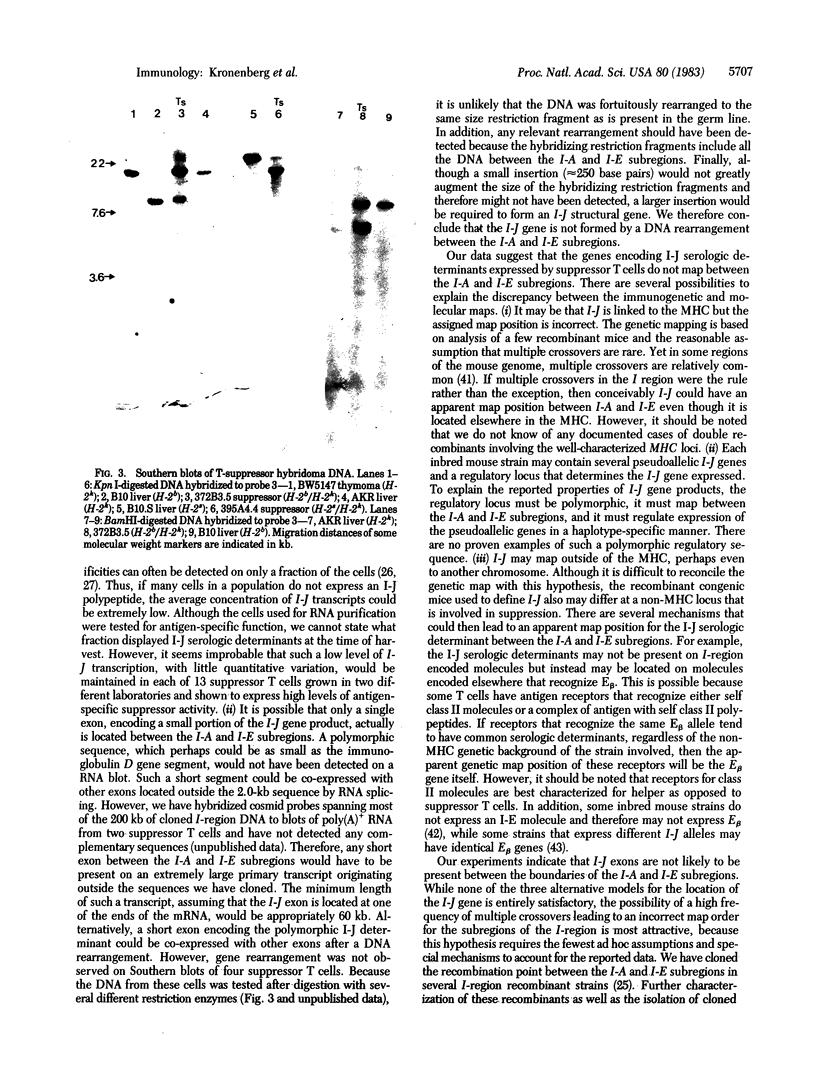
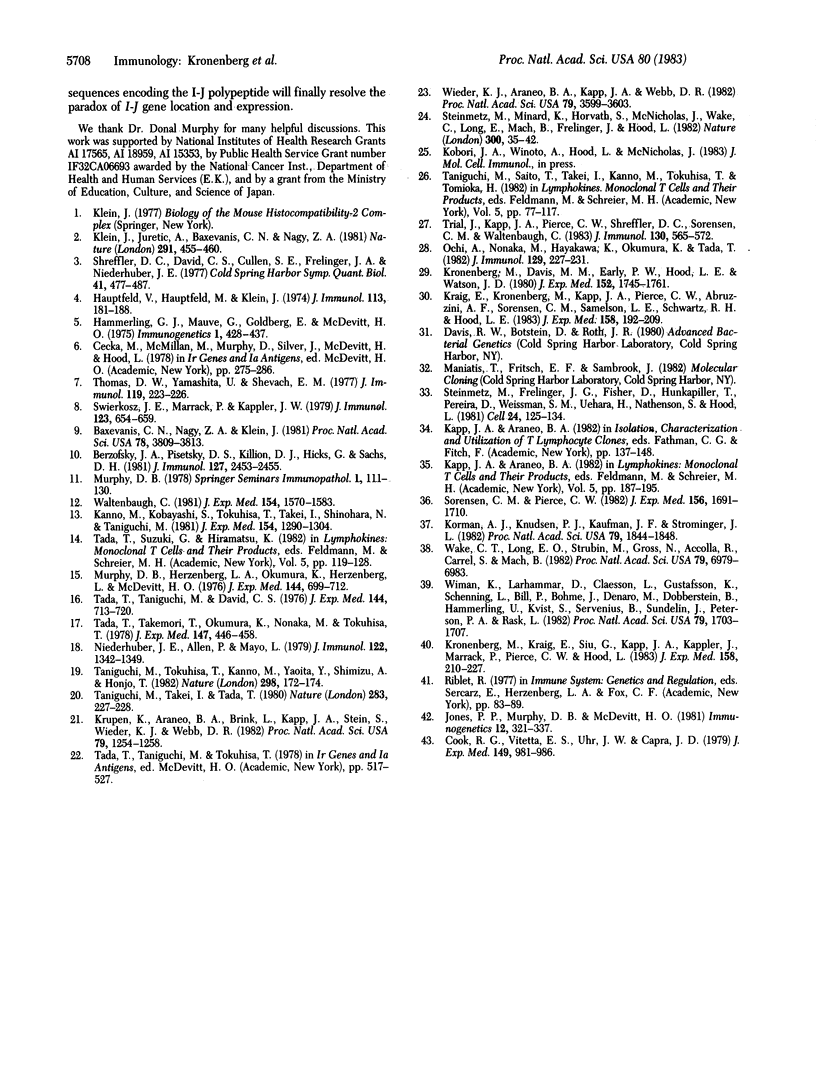
Images in this article
Selected References
These references are in PubMed. This may not be the complete list of references from this article.
- Baxevanis C. N., Nagy Z. A., Klein J. A novel type of T-T cell interaction removes the requirement for I-B region in the H-2 complex. Proc Natl Acad Sci U S A. 1981 Jun;78(6):3809–3813. doi: 10.1073/pnas.78.6.3809. [DOI] [PMC free article] [PubMed] [Google Scholar]
- Berzofsky J. A., Pisetsky D. S., Killion D. J., Hicks G., Sachs D. H. Ir genes of different high responder haplotypes for staphylococcal nuclease are not allelic. J Immunol. 1981 Dec;127(6):2453–2455. [PubMed] [Google Scholar]
- Cook R. G., Vitetta E. S., Uhr J. W., Capra J. D. Structural studies on the murine Ia alloantigens. V. Evidence that the structural gene for the I-E/C beta polypeptide is encoded within the I-A subregion. J Exp Med. 1979 Apr 1;149(4):981–986. doi: 10.1084/jem.149.4.981. [DOI] [PMC free article] [PubMed] [Google Scholar]
- Hauptfeld V., Hauptfeld M., Klein J. Tissue distribution of I region-associated antigens in the mouse. J Immunol. 1974 Jul;113(1):181–188. [PubMed] [Google Scholar]
- Jones P. P., Murphy D. B., McDevitt H. O. Variable synthesis and expression of E alpha and Ae (E beta) Ia polypeptide chains in mice of different H-2 haplotypes. Immunogenetics. 1981;12(3-4):321–337. doi: 10.1007/BF01561674. [DOI] [PubMed] [Google Scholar]
- Kanno M., Kobayashi S., Tokuhisa T., Takei I., Shinohara N., Taniguchi M. Monoclonal antibodies that recognize the product controlled by a gene in the I-J subregion of the mouse H-2 complex. J Exp Med. 1981 Nov 1;154(5):1290–1304. doi: 10.1084/jem.154.5.1290. [DOI] [PMC free article] [PubMed] [Google Scholar]
- Klein J., Juretic A., Baxevanis C. N., Nagy Z. A. The traditional and a new version of the mouse H-2 complex. Nature. 1981 Jun 11;291(5815):455–460. doi: 10.1038/291455a0. [DOI] [PubMed] [Google Scholar]
- Korman A. J., Knudsen P. J., Kaufman J. F., Strominger J. L. cDNA clones for the heavy chain of HLA-DR antigens obtained after immunopurification of polysomes by monoclonal antibody. Proc Natl Acad Sci U S A. 1982 Mar;79(6):1844–1848. doi: 10.1073/pnas.79.6.1844. [DOI] [PMC free article] [PubMed] [Google Scholar]
- Kraig E., Kronenberg M., Kapp J. A., Pierce C. W., Abruzzini A. F., Sorensen C. M., Samelson L. E., Schwartz R. H., Hood L. E. T and B cells that recognize the same antigen do not transcribe similar heavy chain variable region gene segments. J Exp Med. 1983 Jul 1;158(1):192–209. doi: 10.1084/jem.158.1.192. [DOI] [PMC free article] [PubMed] [Google Scholar]
- Kronenberg M., Davis M. M., Early P. W., Hood L. E., Watson J. D. Helper and killer T cells do not express B cell immunoglobulin joining and constant region gene segments. J Exp Med. 1980 Dec 1;152(6):1745–1761. doi: 10.1084/jem.152.6.1745. [DOI] [PMC free article] [PubMed] [Google Scholar]
- Kronenberg M., Kraig E., Siu G., Kapp J. A., Kappler J., Marrack P., Pierce C. W., Hood L. Three T cell hybridomas do not contain detectable heavy chain variable gene transcripts. J Exp Med. 1983 Jul 1;158(1):210–227. doi: 10.1084/jem.158.1.210. [DOI] [PMC free article] [PubMed] [Google Scholar]
- Krupen K., Araneo B. A., Brink L., Kapp J. A., Stein S., Wieder K. J., Webb D. R. Purification and characterization of a monoclonal T-cell suppressor factor specific for poly(LGlu60LAla30LTyr10). Proc Natl Acad Sci U S A. 1982 Feb;79(4):1254–1258. doi: 10.1073/pnas.79.4.1254. [DOI] [PMC free article] [PubMed] [Google Scholar]
- Murphy D. B., Herzenberg L. A., Okumura K., Herzenberg L. A., McDevitt H. O. A new I subregion (I-J) marked by a locus (Ia-4) controlling surface determinants on suppressor T lymphocytes. J Exp Med. 1976 Sep 1;144(3):699–712. doi: 10.1084/jem.144.3.699. [DOI] [PMC free article] [PubMed] [Google Scholar]
- Niederhuber J. E., Allen P., Mayo L. The expression of Ia antigenic determinants on macrophages required for the in vitro antibody response. J Immunol. 1979 Apr;122(4):1342–1349. [PubMed] [Google Scholar]
- Ochi A., Nonaka M., Hayakawa K., Okumura K., Tada T. Two loci in I-J subregion of the H-2 complex controlling molecules selectively expressed on suppressor and helper T cells. J Immunol. 1982 Jul;129(1):227–231. [PubMed] [Google Scholar]
- Shreffler D. C., David C. S., Cullen S. E., Frelinger J. A., Niederhuber J. E. Serological and functional evidence for further subdivision of the I regions of the H-2 gene complex. Cold Spring Harb Symp Quant Biol. 1977;41(Pt 2):477–487. doi: 10.1101/sqb.1977.041.01.055. [DOI] [PubMed] [Google Scholar]
- Sorensen C. M., Pierce C. W. Antigen-specific suppression in genetic responder mice to L-glutamic acid60-L-alanine30-L-tyrosine10 (GAT). Characterization of conventional and hybridoma-derived factors produced by suppressor T cells from mice injected as neonates with syngeneic GAT macrophages. J Exp Med. 1982 Dec 1;156(6):1691–1710. doi: 10.1084/jem.156.6.1691. [DOI] [PMC free article] [PubMed] [Google Scholar]
- Steinmetz M., Frelinger J. G., Fisher D., Hunkapiller T., Pereira D., Weissman S. M., Uehara H., Nathenson S., Hood L. Three cDNA clones encoding mouse transplantation antigens: homology to immunoglobulin genes. Cell. 1981 Apr;24(1):125–134. doi: 10.1016/0092-8674(81)90508-0. [DOI] [PubMed] [Google Scholar]
- Steinmetz M., Minard K., Horvath S., McNicholas J., Srelinger J., Wake C., Long E., Mach B., Hood L. A molecular map of the immune response region from the major histocompatibility complex of the mouse. Nature. 1982 Nov 4;300(5887):35–42. doi: 10.1038/300035a0. [DOI] [PubMed] [Google Scholar]
- Swierkosz J. E., Marrack P., Kappler J. W. The role of H-2-linked genes in helper T cell function. V. I-region control of helper T cell interaction with antigen-presenting macrophages. J Immunol. 1979 Aug;123(2):654–659. [PubMed] [Google Scholar]
- Tada T., Takemori T., Okumura K., Nonaka M., Tokuhisa T. Two distinct types of helper T cells involved in the secondary antibody response: independent and synergistic effects of Ia- and Ia+ helper T cells. J Exp Med. 1978 Feb 1;147(2):446–458. doi: 10.1084/jem.147.2.446. [DOI] [PMC free article] [PubMed] [Google Scholar]
- Tada T., Taniguchi M., David C. S. Properties of the antigen-specific suppressive T-cell factor in the regulation of antibody response of the mouse. IV. Special subregion assignment of the gene(s) that codes for the suppressive T-cell factor in the H-2 histocompatibility complex. J Exp Med. 1976 Sep 1;144(3):713–725. doi: 10.1084/jem.144.3.713. [DOI] [PMC free article] [PubMed] [Google Scholar]
- Taniguchi M., Takei I., Tada T. Functional and molecular organisation of an antigen-specific suppressor factor from a T-cell hybridoma. Nature. 1980 Jan 10;283(5743):227–228. doi: 10.1038/283227a0. [DOI] [PubMed] [Google Scholar]
- Taniguchi M., Tokuhisa T., Kanno M., Yaoita Y., Shimizu A., Honjo T. Reconstitution of antigen-specific suppressor activity with translation products of mRNA. Nature. 1982 Jul 8;298(5870):172–174. doi: 10.1038/298172a0. [DOI] [PubMed] [Google Scholar]
- Thomas D. W., Yamashita U., Shevach E. M. Nature of the antigenic complex recognized by T lymphocytes. IV. Inhibition of antigen-specific T cell proliferation by antibodies to stimulator macrophage Ia antigens. J Immunol. 1977 Jul;119(1):223–226. [PubMed] [Google Scholar]
- Trial J., Kapp J. A., Pierce C. W., Shreffler D. C., Sorensen C. M., Waltenbaugh C. Expression of cell surface antigens by suppressor T cell hybridomas. I. Comparison of phenotype and function. J Immunol. 1983 Feb;130(2):565–572. [PubMed] [Google Scholar]
- Wake C. T., Long E. O., Strubin M., Gross N., Accolla R., Carrel S., Mach B. Isolation of cDNA clones encoding HLA-DR alpha chains. Proc Natl Acad Sci U S A. 1982 Nov;79(22):6979–6983. doi: 10.1073/pnas.79.22.6979. [DOI] [PMC free article] [PubMed] [Google Scholar]
- Waltenbaugh C. Regulation of immune responses by I-J gene products. I. Production and characterization of anti-I-J monoclonal antibodies. J Exp Med. 1981 Nov 1;154(5):1570–1583. doi: 10.1084/jem.154.5.1570. [DOI] [PMC free article] [PubMed] [Google Scholar]
- Wieder K. J., Araneo B. A., Kapp J. A., Webb D. R. Cell-free translation of a biologically active, antigen-specific suppressor T cell factor. Proc Natl Acad Sci U S A. 1982 Jun;79(11):3599–3603. doi: 10.1073/pnas.79.11.3599. [DOI] [PMC free article] [PubMed] [Google Scholar]
- Wiman K., Larhammar D., Claesson L., Gustafsson K., Schenning L., Bill P., Böhme J., Denaro M., Dobberstein B., Hammerling U. Isolation and identification of a cDNA clone corresponding to an HLA-DR antigen beta chain. Proc Natl Acad Sci U S A. 1982 Mar;79(6):1703–1707. doi: 10.1073/pnas.79.6.1703. [DOI] [PMC free article] [PubMed] [Google Scholar]



